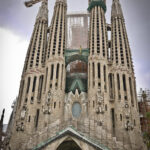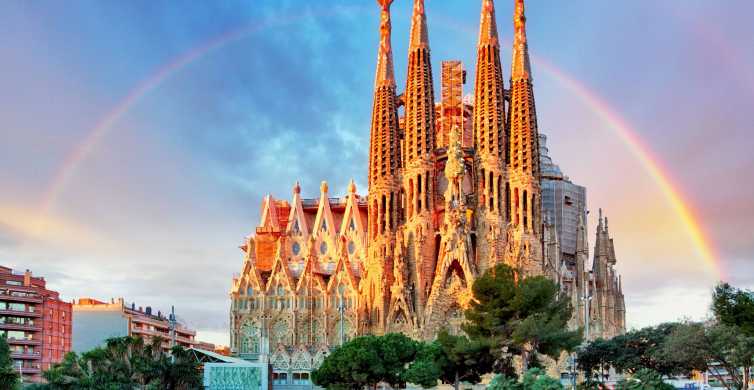
Discover the architectural wonder of Antoni Gaudí as you stroll through the iconic Sagrada Familia in Barcelona. This masterpiece, still under construction, is a testament to Gaudí's vision and creativity, attracting millions of visitors each year.
Join us on an unforgettable journey with Sagrada Familia Barcelona: Immerse Yourself in a Captivating Walking Tour. Experience the intricate details, stunning facades, and rich history that make this basilica an essential part of Barcelona's cultural heritage.
Exploring the Architectural Marvels of Sagrada Familia Barcelona
The Sagrada Familia is not merely a church; it is an architectural journey that embodies the essence of nature through its intricate designs. As you explore its various facades, you will encounter the Nativity Facade, renowned for its vibrant sculptures and elaborate depictions of biblical scenes, showcasing Gaudí's dedication to storytelling through architecture.
One of the most captivating aspects of the Sagrada Familia is its unique columns that resemble trees, creating the illusion of a forest within the basilica. This design not only enhances the aesthetic appeal but also supports the structure organically. Visitors can marvel at how these columns branch out, providing both strength and beauty to the interior space.
As you walk through the basilica, don't miss the opportunity to admire the stunning stained glass windows. The interplay of light that filters through these vibrant hues transforms the interior into a spiritual experience, reflecting Gaudí's intention to connect the divine with the earthly. Here are some highlights of the stained glass:
- Color Palette: A transition from cool blues to warm reds.
- Symbolism: Each window tells a story, illustrating moments from the life of Christ.
- Artistic Style: A blend of Gothic and Art Nouveau influences.
In summary, exploring the architectural marvels of the Sagrada Familia offers a unique glimpse into Gaudí's genius. Each element, from the facades to the interiors, is designed with profound meaning and unparalleled creativity, making your visit a truly enriching experience.
A Complete Guide to the History of Sagrada Familia
The Sagrada Familia was commissioned in 1882, and from the beginning, it has been a project marked by vision and ambition. Antoni Gaudí took over the project in 1883, infusing it with his distinct architectural style that integrates forms from nature and religious symbolism. With construction still ongoing, it is estimated that the basilica will be completed in the coming decades, preserving Gaudí's original vision while adapting to modern advancements.
Throughout its history, the Sagrada Familia has faced numerous challenges, including financial difficulties, wars, and disruptions due to its unique construction methods. Despite these hurdles, the project has remained a symbol of resilience and dedication, with a workforce of skilled artisans and volunteers contributing to its ongoing development. Here are a few key milestones in its construction:
- 1882: Groundbreaking and initial design by Francisco de Paula del Villar.
- 1883: Gaudí becomes the chief architect.
- 1936: Construction halts due to the Spanish Civil War, leading to the loss of many of Gaudí's original plans.
- 2010: Gaudí is posthumously awarded the title of Saint.
The architectural significance of the Sagrada Familia has garnered international recognition. In 2005, it was declared a UNESCO World Heritage Site, celebrated for its innovative design and the way it encapsulates the spirit of Catalan Modernism. The basilica is also a reflection of Gaudí's deep religious faith, which influenced both its artistic elements and structural integrity, creating a harmonious blend of spirituality and architecture.
As visitors explore the Sagrada Familia, they are not just witnessing a building; they are experiencing a living monument that tells the story of a city's culture and history. Each intricate detail is steeped in meaning, making the Sagrada Familia an enduring symbol of Barcelona's architectural heritage and a testament to the genius of Antoni Gaudí.
Top Tips for an Unforgettable Walking Tour of Sagrada Familia
To ensure a memorable walking tour of the Sagrada Familia, consider visiting during off-peak hours, such as early mornings or late afternoons. This way, you can avoid the large crowds and fully immerse yourself in the stunning details of Gaudí's masterpiece. Additionally, make sure to wear comfortable shoes as you'll be walking a lot and exploring various levels of the basilica.
Another tip is to download an audio guide or an app that provides insights into the architecture and history of the Sagrada Familia. This can enhance your experience by offering context for the intricate designs and symbolism embedded in the structure. Here are some features to look for in a good guide:
- Historical Context: Learn about the basilica’s construction timeline and Gaudí's vision.
- Architectural Highlights: Discover key elements like the Nativity and Passion Facades.
- Interactive Maps: Navigate through the site with ease.
Don't forget to take breaks and enjoy the surrounding park area, where you can appreciate the basilica from different angles. Consider bringing a camera or sketchbook, as capturing the unique forms and colors can create lasting memories. Here’s a quick checklist to enhance your visit:
- Plan your visit ahead and book tickets online to skip the lines.
- Bring water and snacks for a refreshing break.
- Check for any special events or guided tours that might be taking place.
- Respect the quiet atmosphere during your visit, especially in sacred areas.
Finally, be prepared for the ever-changing light within the basilica, as it transforms the space throughout the day. This dynamic effect not only enhances the spiritual atmosphere but also highlights the beauty of the stained glass windows. Remember, each visit to the Sagrada Familia can offer a different experience, making it a place worth revisiting.
Discover the Hidden Details of Sagrada Familia's Interior
As you venture into the interior of the Sagrada Familia, take a moment to appreciate the hidden details that reveal Gaudí's deep understanding of light and space. The basilica's columns, inspired by nature, create a breathtaking canopy that mimics a forest. This design not only serves a structural purpose but also immerses visitors in a serene atmosphere, inviting contemplation and reflection.
The play of light within the Sagrada Familia is nothing short of magical. The stained glass windows, each crafted with meticulous care, flood the interior with a kaleidoscope of colors. This vibrant light transforms throughout the day, creating a dynamic environment that enhances the emotional and spiritual experience of the space. Be sure to look for:
- Symbolic Colors: Each hue represents different aspects of spirituality and nature.
- Intricate Designs: The patterns often tell stories from the Bible, enriching your understanding of the narratives.
- Cultural Influences: The blend of various artistic styles showcases the fusion of tradition and innovation.
Don't overlook the beautifully crafted sacred sculptures that adorn the interior walls. Each figure is infused with life and emotion, reflecting Gaudí's vision of a church that speaks to the heart. The craftsmanship is a testament to the skilled artisans who continue to work on the basilica, ensuring that every detail aligns with Gaudí's original intentions. Observing these elements offers visitors a unique glimpse into the artist's mind and the spiritual essence he intended to convey.
Finally, the ceiling of the Sagrada Familia is an architectural marvel in its own right. The geometric patterns and organic forms draw the eye upward, instilling a feeling of awe. As you gaze at this incredible structure, consider how Gaudí’s designs harmoniously blend art with faith, making the interior a profound experience that echoes the beauty of the divine.
Sagrada Familia Barcelona: Best Time to Visit and Tour Options
The best time to visit the Sagrada Familia in Barcelona is during the shoulder seasons of spring (March to May) and fall (September to November). During these months, the weather is pleasantly mild, and the tourist crowds are smaller compared to the peak summer months. Early mornings or late afternoons also offer a quieter atmosphere, allowing you to fully appreciate the intricate details and spiritual ambiance of this architectural masterpiece.
When planning your visit, consider the various tour options available. You can choose from a basic entry ticket or opt for guided tours that provide in-depth insights into Gaudí's work and the basilica's history. Additionally, there are options for audio guides, which allow you to explore at your own pace while still learning about key features. Here’s a quick overview of the tour options:
- Basic Entry Ticket: Access to the basilica with audio guide.
- Guided Tours: Expert-led exploration, offering detailed context.
- Combined Tickets: Entry to nearby attractions like the Casa Batlló.
For those wishing to experience the basilica from a different angle, consider booking a tower tour. This option allows you to ascend one of the towers for breathtaking views of Barcelona and a unique perspective on Gaudí's architectural vision. Remember to book in advance, as these tours can fill up quickly, especially during peak tourist seasons.
Interesting Facts About Sagrada Familia You Didn’t Know
The Sagrada Familia holds several fascinating secrets that many visitors might not know. For instance, did you know that its construction has been funded entirely by private donations? This unique financing model highlights the basilica's status as a labor of love from the people rather than a government-funded project. Additionally, the completion date is still a topic of discussion; while many experts predict it will be finished by 2026, the centenary of Gaudí's death, some believe it may take longer due to its intricate designs.
Another intriguing fact is that the Sagrada Familia is designed to have 18 towers, which symbolize the apostles, the Virgin Mary, the four evangelists, and Jesus Christ. Currently, eight towers have been completed, and each one has unique architectural features that tell a story. Visitors can look forward to seeing:
- Jesus Christ Tower: The tallest tower, reaching 172.5 meters.
- Virgin Mary Towers: Representing protection and faith.
- Apostles Towers: Each topped with a symbolic representation related to each apostle.
Moreover, the Sagrada Familia is an evolving masterpiece. Even after Gaudí's tragic death in 1926, architects and artisans continue to interpret his vision, using modern technology to replicate his intricate designs. This ongoing collaboration allows the basilica to grow and adapt, making each visit a fresh experience as new elements are completed and added. The result is a living monument that mirrors both artistic evolution and cultural continuity.
Lastly, the basilica's unique use of light is not just about aesthetics; it’s intricately linked with its spiritual significance. Gaudí intentionally placed windows to ensure that light enters the basilica at different angles throughout the day, enhancing the emotional resonance of the space. This meticulous planning transforms the interior into a celestial experience, inviting reflection and meditation, making it a truly captivating destination.
 The Official Website of Sagrada Familia Barcelona: A Glimpse into Architectural Marvel
The Official Website of Sagrada Familia Barcelona: A Glimpse into Architectural MarvelIf you want to know other articles similar to Sagrada Familia Barcelona: Immerse Yourself in a Captivating Walking Tour you can visit the category WHERE YOU CAN GO.
Leave a Reply










Read more!